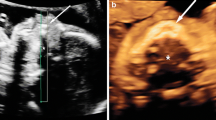Abstract
Objective
To analyze the capability of four-dimensional surface rendering mode ultrasound (4D SRM USG) in the detection of fetal abnormalities, and also compare it with 2D USG.
Materials and methods
A total of 1,379 pregnant women were enrolled in the study, and they all underwent 2D USG screening. In the same session, they were all subsequently screened using 4D USG. The findings of both methods were compared.
Results
A total of 194 fetal anomalies were detected in 176 of 1,379 pregnant women by 2D USG. When all cases, including superficial and non-superficial anomalies, were evaluated together, we found that 2D USG was significantly better than 4D SRM USG in detecting anomalies (p < 0.001). However, 4D SRM USG was superior to 2D USG in terms of image quality, clarity, the distinction between the surrounding structures, and intelligibility among the cases with a superficial anomaly (p < 0.005).
Conclusion
4D USG is superior to 2D USG in detecting malformations related to fetus face, spine, extremities, abdominal wall, and the body surface. However, 4D SRM USG detected only approximately half of the cases with anomalies, and showed a better quality of image in only 15 % of all cases. Therefore, 4D SRM USG may only be suitable for use as a complementary tool in the evaluation of fetal anomalies, especially those of the face, spine, extremity, and abdominal wall.





Similar content being viewed by others
References
Donald I, McVicar J, Brown TG (1961) Demonstration of tissue interfaces within the body by ultrasonic echo sounding. Br J Radiol 34:539–546
Levi S (1998) Routine ultrasound screening of congenital anomalies. An Overview of the European experience. Ann N Y Acad Sci 18(847):86–98
Chaoui R, Heling KS (2006) Three-dimensional ultrasound in prenatal diagnosis. Curr Opin Obstet Gynecol 18(2):192–202
Kurjak A, Abo- Yaqoub S, Stanojevic M et al (2010) The potential of 4D sonography in the assessment of fetal neurobehavior-multicentric study in high risk pregnancies. J Perinat Med 38(1):77–82
Andonotopo W, Kurjak A (2006) The assessment of fetal behavior of growth restricted fetuses by 4D sonography. J Perinat Med 34(6):471–478
Yigiter AB, Kavak ZN (2006) Normal standards of fetal behavior assessed by four-dimensional sonography. J Matern Fetal Neonatal Med 19(11):707–721
Xu HX, Zhang QP, Lu MD, Wiao XT (2002) Comparison of two-dimensional and three-dimensional sonography in evaluating fetal malformations. J Clin Ultrasound 30(9):515–525
Gonçalves LF, Lee W, Espinoza J, Romero R (2005) Three and 4-dimensional ultrasound in obstetric practice: does it help? J Ultrasound Med 24(12):1599–1624
Baba K, Okai T, Kozuma S, Taketani Y (1999) Fetal abnormalities: evaluation with real-time-processible threedimensional US-preliminary report. Radiology 211(2):441–446
Kos M, Hafner T, Funduk-Kurjak B, Bozek T, Kurjak A (2002) Limb deformities and three-dimensionalultrasound. J Perinat Med 30(1):40–47
Merz E, Bahlmann F, Weber G (1995) Volume Scanning in the evaluation of fetal malformations. A new dimension in prenatal diagnosis. Ultrasound Obstet Gynecol 5(4):222–227
Johnson D, Pretorius DH, Riccabona M, Budorick NE, Nelson TR (1997) Three-dimensional ultrasound of the fetal spine. Obstet Gynecol 89(3):434–438
Garjian KV, Pretorius DH, Budorick NE, Cantrell CJ, Johnson DD, Nelson TR (2000) Fetal skeletal dysplasia: three-dimensional US_ Initial experience. Radiology 214(3):717–723
Pretorius D, Nelson T (1994) Prenatal visualization of cranial sutures and fontanelles with three-dimensional ultrasonography. J Ultrasound Med 13(11):871–876
Chaoui R, Levaillant JM, Benoit B, Faro C, Wegrzyn P, Nicolaides KH (2005) Three-dimensional sonographic description of abnormal metopic suture in second- and third- trimester fetuses. Ultrasound Obstet Gynecol 26(7):761–764
Gonçalves LF, Nien JK, Espinoza J et al (2006) What does 2-dimensional imaging add to 3-dimensional obstetric ultrasonography? J Ultrasound Med 25(6):691–699
Benaceraff BR (2006) Tomographic sonography of the fetus: is it accurate enough to be a frontline screen for fetal malformation? J Ultrasound Med 25(6):687–689
Conflict of interest
None.
Author information
Authors and Affiliations
Corresponding author
Rights and permissions
About this article
Cite this article
Öcal, D.F., Nas, T. & Güler, İ. The place of four-dimensional ultrasound in evaluating fetal anomalies. Ir J Med Sci 184, 607–612 (2015). https://doi.org/10.1007/s11845-014-1184-2
Received:
Accepted:
Published:
Issue Date:
DOI: https://doi.org/10.1007/s11845-014-1184-2




